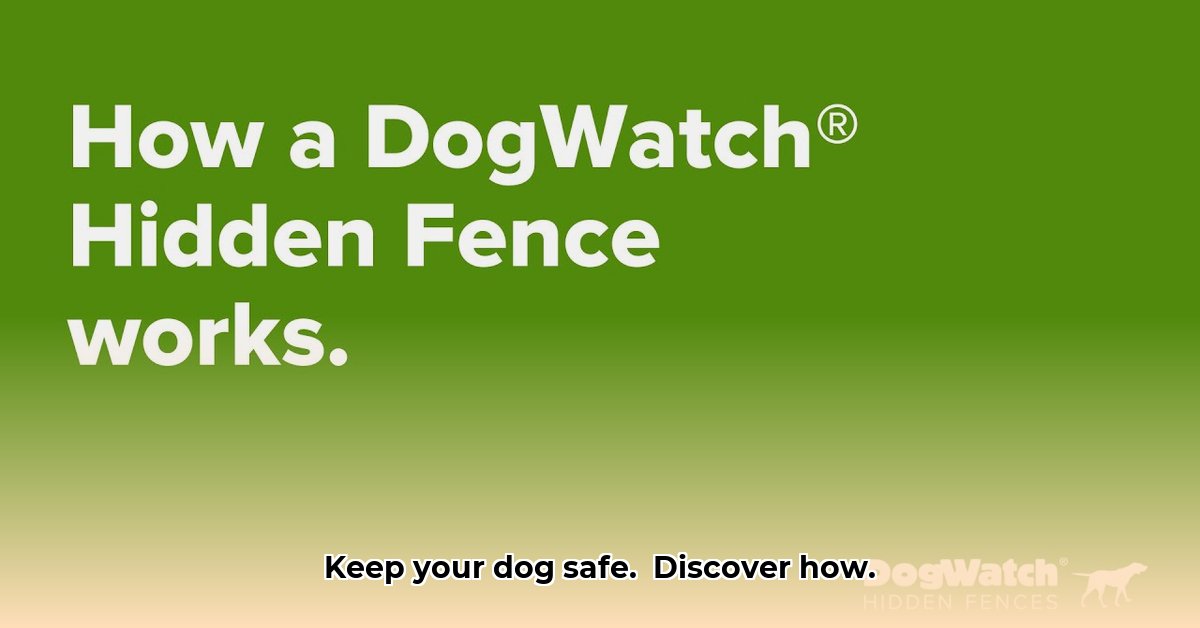
Keeping your beloved canine companion safe and secure is paramount. Traditional fencing can be costly and limit your dog's roaming space, while letting them off-leash carries inherent risks. DogWatch Baltimore offers a sophisticated, humane alternative: an invisible fence system designed for safe and effective pet containment. This comprehensive guide will equip you with the knowledge to make an informed decision, ensuring your dog's safety and happiness.
How DogWatch Works: Understanding the Technology
DogWatch utilizes a three-part system: a transmitter, a receiver collar, and a boundary wire. The transmitter, typically placed indoors, emits a radio signal. This signal creates an invisible boundary defined by a thin wire buried a few inches underground around your yard’s perimeter. Your dog wears a lightweight receiver collar; as they approach the boundary, the collar first issues an audible warning (a beep). If your dog continues, a mild, momentary static correction gently encourages them to return to their safe zone. This is not a harmful shock; instead, it's a safe, effective deterrent.
Installation and Setup: A Step-by-Step Process
While professional installation by a certified DogWatch technician is strongly recommended for optimal performance and warranty coverage, understanding the process is helpful.
1. Planning Your Pet's Safe Zone: Meticulously map your yard, identifying areas where your dog can roam freely and areas to exclude (gardens, neighbor's property).
2. Professional Wire Installation: A DogWatch professional strategically buries the boundary wire, ensuring consistent radio signal reception. This precision is crucial for reliable performance.
3. Transmitter Placement: The transmitter's placement directly impacts signal strength. Your installer chooses the optimal location within your home to maximize coverage and accuracy.
4. Collar Fitting and Adjustment: Proper collar fitting is critical. Your installer will ensure a comfortable but secure fit, adjusting the collar for your dog's size and ensuring the contact points make proper contact with your dog's skin.
5. Training Your Dog: This is the most critical step. Effective training ensures your dog understands and respects the boundaries. (Detailed training guidance follows below).
Training Your Dog: A Gradual and Positive Approach
Training is key to successfully using a DogWatch system, and it's not about punishment, but about teaching and rewarding your dog.
1. Positive Reinforcement is Key: Begin in a small, confined area within the boundary. Reward your dog generously with treats, praise, and playful interaction when they remain within the designated space.
2. Gradual Expansion: As your dog consistently stays within the limited area, slowly expand the perimeter. Never rush this process; proceed at your dog’s pace.
3. Consistency is Crucial: Regular, short training sessions are more effective than infrequent, long ones. Aim for daily sessions of 5-10 minutes to reinforce learning.
4. Addressing Challenges: Some dogs may need more time to adapt. If you encounter difficulties, don't hesitate to contact your installer or a certified dog trainer for support. Adjusting the collar's sensitivity level (with professional guidance) may also prove beneficial.
5. Is my dog habituating to the warning tone? If your dog consistently ignores the warnings, address the situation immediately. Check the collar for proper fit and ensure the boundary wire is intact. Consider seeking professional assistance for training or technological support.
Pros and Cons: A Balanced Perspective
Like any product, DogWatch has its strengths and weaknesses.
Pros:
- Enhanced freedom and exercise for your dog.
- A cost-effective alternative to traditional fences over the long term.
- Humane, safe correction method.
- Customizable boundaries.
- Improved pet safety.
Cons:
- Requires professional installation and consistent training.
- Potential for system malfunctions (rare but possible).
- Effectiveness relies heavily on training.
- Initial investment is higher than some DIY options.
Cost Considerations: The Long-Term Value
While the initial cost of a DogWatch system, including installation and training, is higher than some DIY solutions, remember to factor in the long-term savings compared to traditional fencing. You eliminate the ongoing maintenance, repairs, and potential replacement costs associated with traditional fencing, making DogWatch a cost-effective solution over time.
DogWatch vs. Competitors: Why Choose DogWatch?
DogWatch distinguishes itself through its commitment to personalized training support and a robust system designed for high reliability. While other brands, like Invisible Fence, exist, DogWatch’s emphasis on collaboration between the installer and pet owner enhances the likelihood of success.
Conclusion: Your Path to Safe Pet Containment in Baltimore
Choosing a DogWatch system requires careful consideration of your yard layout, your dog's temperament, and your commitment to consistent training. The result, however, is a safe, effective, and humane way to keep your canine companion secure within your property. Contact a local DogWatch Baltimore dealer today for a personalized consultation. They can assess your needs, answer your questions, and guide you through the process of creating a safe and enjoyable environment for you and your furry friend.